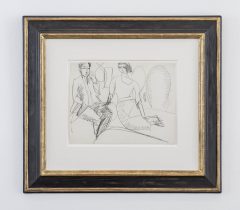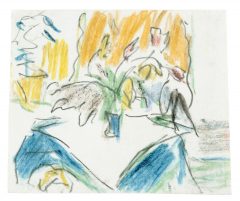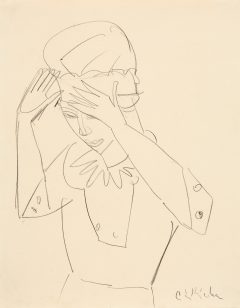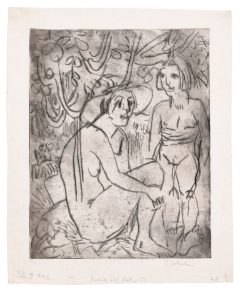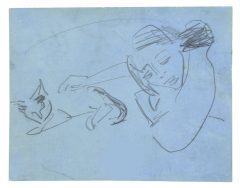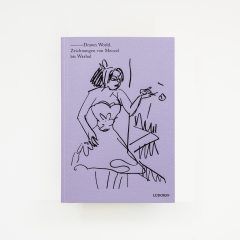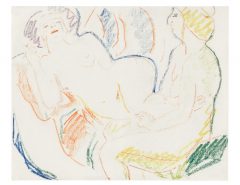Ernst Ludwig Kirchner
Paar im Gespräch, Erna und Gewecke
ca. 1912
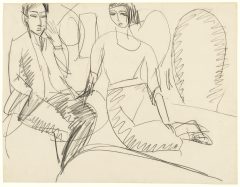
pencil on vellum
28 × 36 cm | 11 × 14 1/4 in
verso with the Basel estate stamp vs by mistake as it was likely executed in Berlin "B Dre/Bi 139" also "K 2415", "C 1069" and "2040" numbered
The work has been registered by the Ernst Ludwig Kirchner Archiv, Wichtrach/Bern
Estate of the artist; Wolfgang Werner, Bremen (1980); Helen Serger La Boetie, New York (1984); Galerie Ilse Schweinsteiger, München (1993); Galerie Kornfeld, Bern (2003); Private Collection Bern
- Galerie Ludorff, "Drawn World: Zeichnungen von Menzel bis Warhol", Düsseldorf 2019, S. 73
- Galerie Welz, "Ernst Ludwig Kirchner (1880-1938) – Ölbilder – Aquarelle – Zeichnungen", Ausst.-Kat., Salzburg 1995, Nr. 16
- Galerie Ilse Schweinsteiger, Ausst.-Kat., München 1993, o. S.
- Kunsthandel Wolfgang Werner, "Max Pechstein – Brücke period and works by Heckel, Nolde, Kirchner, Schmidt-Rottluff", Ausst.-Kat., Bremen 1984, Nr. 20
- Helen Serger/La Boetie, "Max Pechstein and works by Heckel, Nolde, Kirchner, Schmidt-Rottluff. In collaboration with Kunsthandel Wolfgang Werner KG", Ausst.-Kat., New York 1984, o. S.
- Kunsthandel Wolfgang Werner, "Ernst Ludwig Kirchner. Zeichnung, Druckgraphik. Ausstellung zum 100. Geburtstag", Ausst.-Kat., Bremen 1980, Nr. 23
On June 7, 1905, Ernst Ludwig Kirchner, Erich Heckel, Karl Schmidt-Rottluff and Fritz Bleyl founded the artists' association 'Die Brücke' in Dresden, which decisively shaped Expressionism in Germany and had a great influence on modern painting in the 20th century. Inspired by the French Fauves, but also by Scandinavian painters such as Edvard Munch, Kirchner developed a very independent, innovative and expressive style in this important early creative phase, which made his works unmistakable and inspired many subsequent artists.
Our pencil drawing 'Paar im Gespräch, Erna und Gewecke' was created in the same year that Kirchner met the Berlin dancer Erna Schilling, who followed him to Davos and was his partner until his death in 1938. The couple sitting on a Divan is drawn with rapid strokes and sure lines. Erna leans on her right hand, which in turn is on the knee of her conversation partner and good friend Hans Gewecke, a pupil of Ernst Ludwig Kirchner. Erna has put her legs angled to the other side. The left hand grabs the left fetlock, where Erna also seeks support.
While the young woman in her skirt and blouse is dressed rather casually, Gewecke hasn't even taken off his jacket to make herself comfortable. Unlike the balanced Erna, Gewecke sits upright with her legs crossed, rather stiff next to Kirchner's partner. Although he seems to enjoy Erna's closeness, he is astonished at the spontaneous touch. While his right hand remains in his trouser pocket, he has raised his left gesticulating. The glances of the two are directed at the artist and the viewer, respectively, and thus include them in the intimate situation.
Strong black lines give form and stability to the representation. But it is not only the striking outlines that give the depiction its typical Kirchner character. Rather, the artist creates the tension with several very restless, curved lines.
Kirchner leaves us in the dark about the exact environment. He hides the furniture and the surroundings and concentrates solely on the representation of the couple. In this way he lends the energetic situation a great lightness that betrays the outstanding Expressionist.
Kirchner always has his sketchbook at hand to quickly capture situations and experiences with the pen. His main focus is on the totality of figure, space and movement. For Kirchner, the rapid notation of the perceived remains meaningful in all phases of his work: I learned to appreciate the first throw, so that the first sketches and drawings were of great value to me. What have I often done to myself, to consciously complete on canvas what I had easily thrown down in trance on the sketch. 1
11 Ernst Ludwig Kirchner, 'Die Arbeit E. L. Kirchners', um 1925/26, in: Eberhard W. Kornfeld, 'Ernst Ludwig Kirchner. Nachzeichnungen seines Lebens', Bern 1979, recited in: Magdalena M. Moeller/Roland Scotti 'Ernst Ludwig Kirchner – Gemälde, Aquarelle, Zeichnungen und Druckgrafik – Eine Ausstellung zum 60. Todestag', Ausst.-Kat., München 1998, p. 12.
